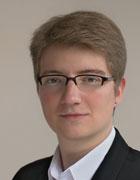Loading
Dr. Dávid M. Gyurkó
- Place and date of birth: Budapest, 2nd September 1981.
- Nationality: Hungarian
- E-mail: gyurko.david [at] med.semmelweis-univ.hu
- 2010-: PhD student at the Semmelweis University, Department of Medical Chemistry, Molecular Biology and Pathobiochemistry. Supervisor: Prof. Peter Csermely, Dr. Csaba Sôti
- 2002-2010: Semmelweis University (SE), Faculty of Medicine, Medical Doctor
- 2000: High school final exam (A+ with distinction; Biology and Physics specialization)
- 1996-2000: Baár-Madas Reformed High School, Budapest
- 2012- Development of a protein-protein interaction database
- 2010- Study of genes related to learning and memory with experimental and network theory approach, PhD student, Semmelweis University, Hungary
- 2010: Genes related to learning and memory in C. elegans. Guest researcher, Biozentrum/Pharmazentrum, University of Basel
- 2010: Effects of cognitive tasks on cerebral blood flow. Thesis (in Hungarian), defended with A+.
- 2009- Network science and neurology; Default mode network of brain. Link Group, supervised by Professor Péter Csermely
- 2008: Development of a program to process physiological signs. Doppler Laboratory
- 2007- Effects of cognitive tasks on cerebral blood flow. Doppler Laboratory, supervised by Assistant Professor Róbert Debreczeni MD
- System level mechanisms of adaptation, learning, memory formation and evolvability: the role of chaperone and other networks. Gyurkó, D. M., Soti, Cs., Csermely, P. Current Protein and Peptide Science. In press, http://arxiv.org/abs/1206.0094
- A Role For RasGAPs in Associative Learning and Memory in C. elegans. Gyurkó, D. M., Fenyves, B., Csermely, P., Sôti, Cs., Steták, A. Hungarian Molecular Life Sciences Conference, 2013, Siófok. Poster presentation.
- ComPPI,a compartmentalized protein-protein interaction database. Veres, D. V., Gyurkó, D. M., Thaler, B., Szalay, K. Zs., Fazekas, D., Korcsmáros, T., Csermely, P. Hungarian Molecular Life Sciences Conference, 2013, Siófok. Poster presentation.
- RasGAPs in the Learning and Memory of C. elegans. Gyurkó, D. M., Sôti, Cs., Csermely, P., Steták, A. FEBS3+ Meeting Conference, 2012, Opatija. Poster presentation.
- Pervasively overlapping network communities, dynamic network centralities and saltatoric information transmission: lessons from billion year-successes of biological networking strategies. Gyurkó, D. M. et al. European Conference on Complex Systems, 2011, Wien. Oral presentation.
- Network strategies to understand the aging process and help age-related drug design. —1/2—Simkó, G. I., Gyurkó, D. M., Veres, D. V, Nánási, T. & Csermely, P., Genome medicine 1, 90 (2009); doi:10.1186/gm90)
- Simkó, G. I., Gyurkó, D., Veres, D. V., Nánási, T. and Csermely, P. (2009) Network strategies to understand the aging process and help age-related drug design. Genome Medicine 2009, 1:90 (28 September 2009)
- Hungarian (native)
- English (advanced level, C1 extended with professional medical language)
- German (intermediate level, B1)
- Computer programming (C++, PHP, JS, SQL, etc.)
- Bioinformatics (network analysis and molecular biology tools)
- Web development; usability, accessibility, open source on the web
- Photography, photographic post-processing
- Neurology, systems neurology, systems biology
- Networks in general, network theory and networks in life sciences
- Photography, visual and fine arts
- Music
- Literature and writing
- Linux, open-source softwares and activities

Contents:

Published by the LINK-Group | Editor: Péter Csermely | Last updated on 10 09 2013
Questions | Address | Design and maintenance | Visitors since 7th July 2004:
Questions | Address | Design and maintenance | Visitors since 7th July 2004:

